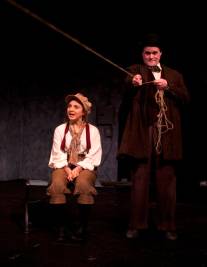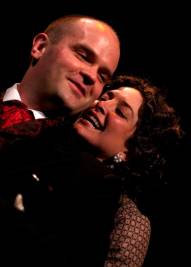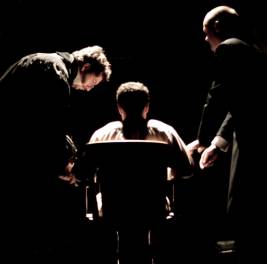
Michael Vukadinovich’s Trog And Clay: An Imagined History Of The Electric Chair may well be one of the funniest plays ever written about actual events, the ingenious playwright having turned the rivalry between electricity pioneers Thomas Edison and George Westinghouse (which led to the first ever execution by electrocution in the U.S.) into a hilarious fact-based absurdist historical farce.
Imaginatively directed by Gary Gardner for L.A. Theatre Ensemble, Trog And Clay delivers both laughs and historical trivia, with an emphasis on the former.
Isaac Wade and Emma Fassler are the titular pair of hobos, a male/female Mutt & Jeff who find themselves innocent pawns in the Edison-Westinghouse feud. This “War Of The Currents,” had Direct Current inventor Edison attempting to discredit his Alternating Current-inventing rival Westinghouse by proving AC to be too dangerous for everyday use, thereby getting it restricted to the execution of convicted murderers. (It was Edison’s hope that the term “Westinghoused” would be as synonymous with execution by electrocution as French Dr. Joseph-Ignace Guillotin’s last name became synonymous with death by beheading.)
To set his plan in motion, Westinghouse hires sad-sack Trog and girl-crazy Clay to catch as many dogs as they can at 25 cents a dog, pooches which he will then use as electrocution guinea pigs. Meanwhile, the dastardly Mr. W. has his mistress Marguerite (who just happens to be Edison’s would-be actress wife) seduce simple-minded William Hassler into murdering his wife, thereby insuring that there will be a convicted killer ready and waiting on Death Row to serve as a the Electric Chair’s very first victim.
Most of the above is historical fact. There was indeed a “War Of The Currents,” a man named William Kemmler did indeed kill his common-law wife Tillie Ziegler with a hatchet on March 29, 1889, and the unfortunate Kemmler was indeed executed by electrocution at New York’s Auburn Prison.
Most of Trog And Clay’s abundant humor comes from its titular duo, a pair who would have done Ionesco proud, and who engage in exchanges like the following:
CLAY: Maybe after we get our quarter we can use it to buy a dog.
TROG: What are you going to do with a dog?
CLAY: Companionship. You know I suffer from boredom.
TROG: What do you need a companion for? You’ve got me. Now shut up.
CLAY: Then I’ll teach it to fight and make us some money.
TROG: You don’t have enough money to keep a dog. Now shut up.
Actual court transcripts provide just about as many laughs. Take for example:
LAWYER: Did you make the autopsy in the case of Matilda Ziegler, known as Matilda Hort?
DOCTOR: I did.
LAWYER: Upon her body?
DOCTOR: Yes, on her body.
Or this one:
LAWYER: How was the body dressed when you first saw it?
DOCTOR: I believe the body was nude when I saw it.
LAWYER: Was Matilda an attractive woman in your estimation?
DOCTOR: There was quite a bit of swelling but I should she say she was average looking.
No wonder Vukadinovich chose farce as his genre of choice when writing Trog And Clay.
Still, as funny as T&C reads on the printed page, its humor truly takes flight in the hands of its comedically gifted cast.
Wade and Fassler may well be L.A. theater’s Prince and Princess Of Quirky as their previous work (Wade most recently in In The Company Of Jane Doe and Fassler in Steel Magnolias) has demonstrated. Here, not unexpectedly, Wade’s deadpan Trog and Fassler’s wide-eyed Clay are nonstop delights. Paige White deliciously spoofs 19th Century acting as would-be star Marguerite Westinghouse, and has a great way with a punch line. Matt Weedman and Mike Kindle play it straight as Edison and Westinghouse and are all the funnier for not camping it up. As the autopsy-performing doctor, Drew Crabtree has great fun on the witness stand spouting quotes from the court record which prove that fact is indeed sometimes stranger than fiction. The same can be said for Brian Allman’s judge, whose every mention of Matilda Ziegler is followed by “otherwise called Matilda Hort” to the point of absurdity. Finally, there is the amazing Ariel Goldberg, the hilariously humorless party-pooping C.B. Baldwain of last year’s Adeline’s Play, whose very real intensity as the tormented, murderous William Kemmler keeps Trog And Clay rooted in reality. (Goldberg gets laughs, too, by the way.)
Cameron Mock’s cavernous, almost bare set design works beautifully in the Powerhouse, serendipitously built in 1910 as the original structure to house the Southern California Edison Electrical Plant for the city of Santa Monica. Michelle Neumann has designed splendid period costumes and James W. Sudik’s properties are equally era-fitting. Thumbs up too to Wolfgang Lancelot Wachalovsky’s lighting design and Adam Smith’s sound design. Tamara Williams is production stage manager assisted by Heather Kellogg.
With Trog And Clay: An Imagined History Of The Electric Chair, Vukadinovich once again proves himself one of L.A.’s most imaginative young playwrights and L.A. Theatre Ensemble to be one of the city’s best young companies of actors. You don’t need to be a history buff to enjoy every minute of this thoroughly unique and absolutely delightful evening of absurdist historical farce.
Los Angeles Theatre Ensemble, The Powerhouse Theatre, 3116 2nd Street, Santa Monica.
www.powerhousetheatre.com
–Steven Stanley
April 29, 2010






 Since 2007, Steven Stanley's StageSceneLA.com has spotlighted the best in Southern California theater via reviews, interviews, and its annual StageSceneLA Scenies.
Since 2007, Steven Stanley's StageSceneLA.com has spotlighted the best in Southern California theater via reviews, interviews, and its annual StageSceneLA Scenies.







 COPYRIGHT 2024 STEVEN STANLEY :: DESIGN BY
COPYRIGHT 2024 STEVEN STANLEY :: DESIGN BY